The Universe and Solar System | Term 1 Unit 1 | Geography | 6th Social Science - The Solar System | 6th Social Science : Geography : Term 1 Unit 1 : The Universe and Solar System
Chapter: 6th Social Science : Geography : Term 1 Unit 1 : The Universe and Solar System
The Solar System
The Solar System
The word ‘solar’ is
derived from the Roman word ‘sol’, which means ‘Sun God’. The solar system
is believed to have formed about 4.5 billion years ago. The solar system is a gravitationally
bound system which comprises of the Sun, the eight planets, dwarf planets, satellites,
comets, asteroids and meteoroids.
Activity:
Watch
a show in the nearest planetarium. a) Share your experience in the class room. b)
Make an album of interesting facts about the solar system.
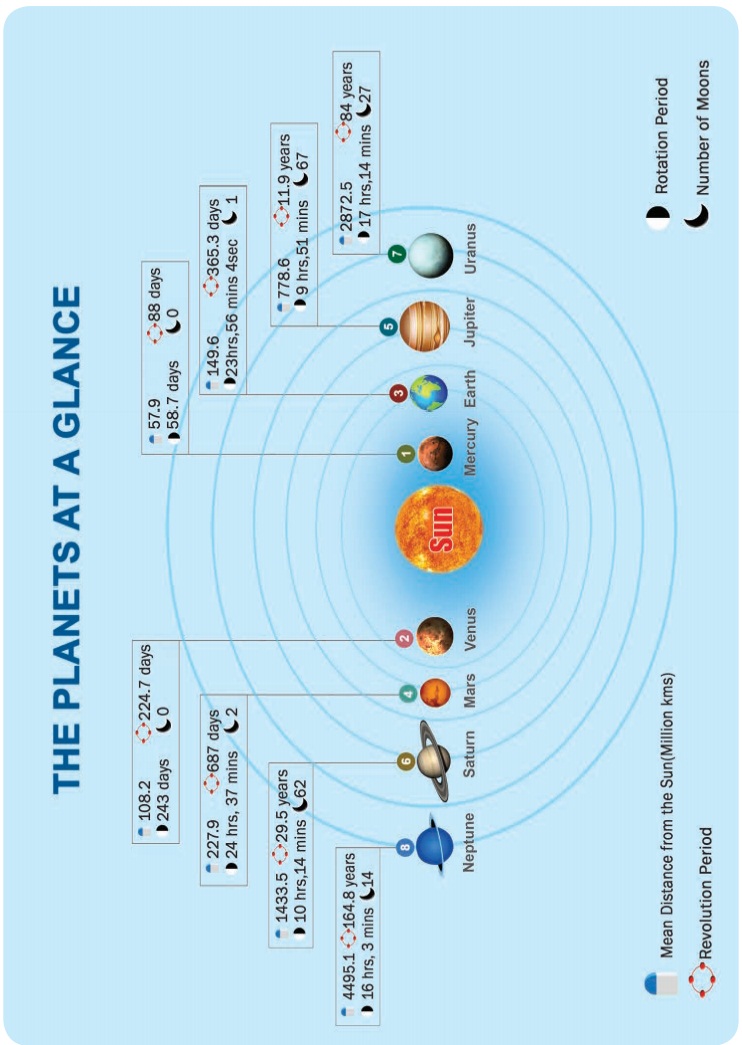
The Sun
The Sun is at the centre of the solar system. Each member revolves around the Sun. The Sun is so huge that
it accounts for 99.8 percent of the entire mass of the solar system. The Sun is
made up of extremely hot gases like Hydrogen and Helium.
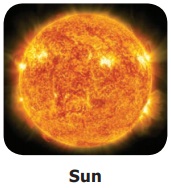
The Sun is a star. It
is self-luminous so it gives light on its own. The surface temperature of the Sun
is about 6,000° C. It is the source of light and heat energy to the entire solar
system. Sunlight takes about 8.3 minutes to reach the Earth.
1.3 million
Earths fit inside the Sun. Imagine how big the Sun is.
Planets
The word planet means
wanderer. There are eight planets in the solar system. They are Mercury,
Venus, Earth, Mars, Jupiter, Saturn,
GEO CONNECT: The ancient
Tamils knew that the planets went around the Sun. For example, in Tamil literature
Sirupanatruppadai, the line ’வாள் நிற விசும்பின் கோள் மீன் சூழ்ந்த இளங்திர் ஞாயிறு’ mentions
that the Sun is surrounded by planets.
Uranus and Neptune.
All the planets rotate anti-clockwise (from west to east) on their own axes except
Venus and Uranus. The elliptical path in which the planets move around the Sun is
known as orbit. The eight planets revolve in their respective orbits because of
the gravitational pull of the Sun. They do not move out of their paths or away from
the solar system.
The four planets nearer
to the Sun are called Inner or Terrestrial Planets (Mercury, Venus, Earth
and Mars). The inner planets are comparatively smaller in size and are composed
of rocks. The surface of inner planets has mountains, volcanoes and craters. The
last four planets are called as Outer Planets or Jovian Planets (Jupiter,
Saturn, Uranus, and Neptune). They are also called Gaseous Giants. An
asteroid belt is found between Mars and Jupiter.
Mnemonic
to remember the order of planets: My Very
Educated Mother Just Showed Us
Neptune.
Mercury (The Nearest Planet)
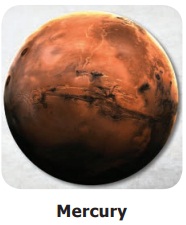
Mercury
is the smallest and closest planet to the Sun. It is named after the Roman deity
‘Mercury’, the messenger to the Gods.
It is an airless and waterless planet. It does not have an atmosphere and so experiences extremes
of temperature. It has no natural satellites. Mercury can be viewed in the morning
and evening with naked eye.
Venus (The Hottest Planet)
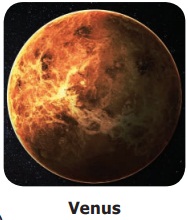
Venus is
the second planet from the Sun. It is called Earth’s twin, as it is almost the same
size as the Earth. It has the longest rotation period (243 days) among the planets in the Solar system. It rotates
in the opposite direction to all other planets except Uranus. It has no natural
satellites like Mercury. It is named after the Roman goddess of love and beauty.
It is often visible in the mornings and the evenings and so it is frequently called
as the Morning Star and the Evening Star. After the Moon, it
is the brightest natural object in the night sky.
HOTS:
Even though Mercury is the nearest
planet to the Sun, Venus is the hottest one. Guess why?
Earth (The Living Planet)
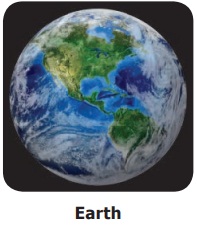
The Earth
is the third planet from the Sun and the fifth largest planet in the solar system.
It is called ‘blue planet’ or ‘watery planet’ because three-fourth
of the Earth is covered by water. The Earth is the only planet in the solar system
which is not named after any Greek or Roman deity. It is the only planet known to
support life. The polar diameter of the Earth is 12, 714 km and the equatorial diameter
is 12, 756 km. The Earth revolves around the Sun at a speed of about 30 km per second.
Life is possible on Earth because of the presence of land, air and water. The only
natural satellite of the Earth is the Moon.
The distance
between the Sun and the Earth is about 150 million kilometre. A flight flying at
a speed of 800 km per hour from the Earth would take 21 years to reach the Sun.
Mars (The Red Planet)
Mars is
the fourth planet from the Sun and the second smallest planet in the solar system,
after Mercury. It is named after the Roman God of war. It appears red in colour due to the presence of iron oxide on its
surface. So, it is often described as The Red Planet. It has a thin atmosphere.
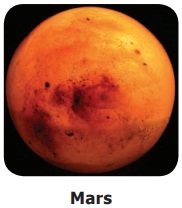
On 24th
September, 2014 Mangalyan (Mars Orbiter Mission - MOM), launched by the Indian Space
Research Organization (ISRO), reached the orbit of Mars to analyze its atmosphere
and topography. ISRO has now become the fourth space agency to reach Mars after
the Soviet Space programme, NASA and the European Space Agency.
It also has polar
ice caps like the Earth. Mars has two natural satellites namely Phobos and Deimos.
Many orbiters and rovers have been launched to explore this planet.
Jupiter (the Largest Planet)
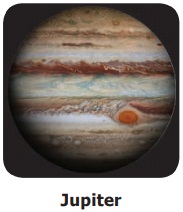
Jupiter is the fifth
planet from the Sun and the largest planet in the solar system. It is named after
the king of the Roman gods. It is the third brightest object in the night sky, after
moon and Venus. It is the fastest spinning planet in the solar system. It is called
a gas giant planet. Its atmosphere is made up of mostly Hydrogen and Helium like
the Sun. It has the largest number of natural satellites. Io, Europa, Ganymede and
Callisto are a few large satellites of Jupiter.
Saturn (The Ringed planet)

Saturn is the sixth
planet from the Sun and the second largest planet in the solar system, after Jupiter.
It is named after the Roman god of agriculture. Saturn has many rings around it.
These rings are huge and are mostly made up of ice, rocks and dust particles.
Saturn has 62 natural
satellites around it. Titan, Saturn’s largest moon, is the only satellite in the
solar system that has clouds and dense atmosphere composed of nitrogen and methane.
The specific gravity of Saturn is less than that of water.
HOTS: If you
could put Saturn in a large enough ocean it would fl oat. Guess why?
Uranus (The Somersaulting planet)
Uranus is the seventh
planet from the Sun. It was the fi rst t be discovered
with a telescope by the astronomer William Herschel
in 1781. It appears green due to the
presence of methane. It is named after the Greek god of the sky.
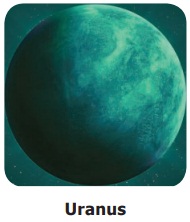
It rotates on its axis
from east to west like Venus. Its axis is tilted so much that, it appears to orbit
the Sun on its sides like a rolling ball. Uranus has 27 natural satellites, of which
Titania is the largest.
Neptune (The coldest Planet)
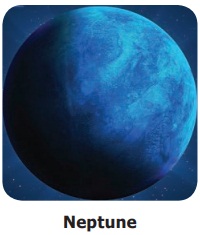
Neptune is the eighth and the farthest planet from the Sun. There are strong winds in this planet. It is named after the Roman god of sea. Neptune has 14 natural satellites, the largest being Triton. Because of its distance from the Sun, Neptune is one of the coldest planets in the solar system. The striking blue and white features of Neptune help to distinguish it from Uranus.
The Dwarf Planets
HOTS:
Imagine you were on a space craft
travelling at the speed of light from Earth, how long would it take to reach the
Sun?
Dwarf planets are small
celestial bodies found beyond the planet Neptune. They are extremely cold and dark.
They are almost spherical in shape, but unlike planets they can share their orbit
with other dwarf planets. The five dwarf planets of the solar system are Pluto,
Ceres, Eris, Makemake and Haumea.
The Moon - Earth’s Satellite

Satellites are celestial
objects, which revolve around the planets. The moon is the Earth’s only satellite.
It revolves around the Earth once in every 27 days 8 hours. It takes about the same
time for it to complete one rotation around its axis. It has no atmosphere. The
surface of the moon is characterized by craters created by the impact of meteors.
The distance between the moon and the Earth is about 3, 84,400 km. The size of
the moon is one-quarter of the Earth. The Moon is the only celestial body where
humans have landed.
HOTS:
We see only one side of the Moon
always. Why?
Asteroids
Asteroids are small
solid objects that move around the Sun. They are found as a belt between Mars and
Jupiter. They are too small to be called as planets. They are also known as Planetoids
or Minor Planets.
Fact: ISRO launched India’s first ever Moon mission, Chandrayaan -
1 in 2008.
Comets
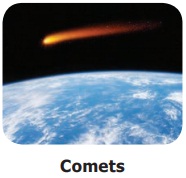
A comet
is a celestial object made up of a head and a tail. The head of a comet consists
of solid particles held together by ice and the
tail is made of gases. Halley’s Comet is the most famous comet which comes close
to the Earth every 76 years. It last appeared in 1986 and will next appear in 2061.
Meteors and Meteorites
A meteor is a stone
like or metallic body. When entering into the Earth’s atmosphere, most of them burn.
As they often appear as streaks of light in the sky, they are also known as Shooting
Stars. Meteors which strike the Earth’s surface are called meteorites.
Related Topics